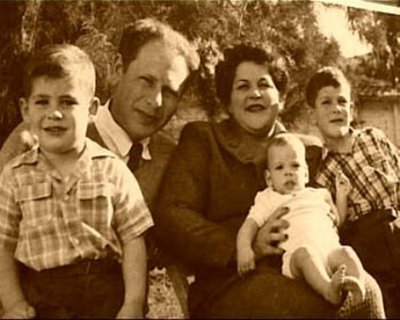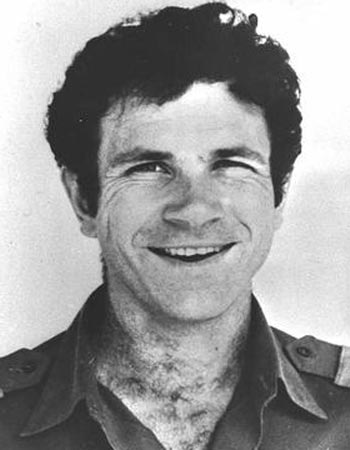___

Prime Minister Benjamin Netanyahu with his father, Benzion, during a memorial ceremony for Yoni Netanyahu at Mount Herzl military cemetery, Jerusalem, 2007 (photo credit: Michal Fattal/Flash90)

Yonathan Netanyahu –

Yoni, Bibi and Iddo Netanyahu (Courtesy Netanyahu family)
:quality(85)//s3.amazonaws.com/arc-wordpress-client-uploads/infobae-wp/wp-content/uploads/2016/10/26171108/Netanyahu-1920-1.jpg)
——

———

The Republican-controlled House of Representatives invited me to address a joint session of Congress on July 10, 1996, and I was received warmly on both sides of the aisle.
GREAT SPEECH
https://www.c-span.org/video/?73411-1/israel-prime-minister-speech#!
SPEECH
If I could only get the Knesset to vote like this.
Mr. Speaker, Mr. Vice-President, members of Congress,
This is not the first time that a Prime Minister of Israel addresses a joint meeting of Congress. My immediate predecessor, Shimon Peres, addressed this body — and before him, the late Yitzhak Rabin, who was tragically cut down by a despicable, savage assassin. We are grateful that Israeli democracy has proved resilient enough to overcome this barbaric act, but we shall always carry with us the pain of this tragedy.
I recognize, Mr. Speaker, that the great honor you have bestowed on me is not personal. It is a tribute to the unshakable fact that the unique relationship between Israel and the United States transcends politics and parties, governments and diplomacy. It is a relationship between two peoples who share a total commitment to the spirit of democracy, and infinite dedication to freedom.
We have a common vision of how societies should be governed, of how civilization should be advanced. We both believe in eternal values, we both believe in the Almighty. We both follow traditions hallowed by time and experience.
We admire America not only for its dynamism, and for its power, and for its wealth. We admire America for its moral force. As Jews and as Israelis, we are proud that this moral force is derived from the Bible and the precepts of morality that the Jewish people have given the world.
Of course, Israel and the United States also have common interests. But our bonds go well beyond such interests. In the 19th century, citizens of all free states viewed France as the great guardian of liberty. In the 20th century, every free person looks to America as the champion of freedom.
Yesterday my wife and I spent a very moving hour at Arlington Cemetery, and we saw there the evidence of the price you paid for that freedom — in the lives of your best and brightest young men. And it’s a toll that is exacted from you — from all of us, but from you, these very days.
I think it was the terrible misfortune of the Jewish people that, in the first half of this century, the United States had not yet assumed its pivotal role in the world. And it has been our great fortune that, in the second half of this century, with the miraculous renewal of Jewish nationhood, the United States became the preeminent power in the world.
You, the people of America, offered the fledgling Jewish state succor and support. You stood by us time and time again, against the forces of tyranny and totalitarianism. I know that I speak for every Israeli and every Jew throughout the world when I say to you today: Thank you, people of America.
Perhaps our most demanding joint effort has been the endless quest to achieve peace and stability for Israel and its Arab neighbors. American presidents have joined successive Israeli governments in an untiring effort to attain this peace.
The first historic breakthrough was led by Prime Minister Begin and Presidents Carter and Sadat at Camp David. The most recent success was our pact with Jordan under the auspices of President Clinton. These efforts, I believe, are clear proof of our intentions and our direction. We want peace. We want peace with all our neighbors. We have no quarrel with them which cannot be resolved by peaceful means. Nor, I must say, do we have a quarrel with Islam. We reject the thesis of an inevitable clash of civilizations. We do not subscribe to the idea that Islam has replaced Communism as the new rival of the West, because our conflict is specific. It is with those militant fanatics who pervert the central tenets of a great faith towards violence and world domination. Our hand is stretched in peace to all who would grasp it. We don’t care about their religion. We don’t care about their national identity. We don’t care about their ideological belief. We care about peace, and our hand is stretched out to peace.
Every Israeli wants peace. I don’t think there is a people who has yearned, prayed and sacrificed more for peace than we have. There is not a family in Israel that has not suffered the unbearable agony of war and, directly or indirectly, the excruciating, ever-lasting pain of grief. The mandate we have received from the people of Israel is to continue the search for an end to wars and an end to grief. I promise you: We are going to live up to this mandate. We will continue the quest for peace, and, to this end, we are ready to resume negotiations with the Palestinian Authority on the implementation of our Interim Agreement.
I want to say something about agreements. Some of you speak Latin, or at least studied Latin. Pacta sunt servanta — we believe agreements are made to be kept. This is our policy, and we expect the Palestinian side to abide by its commitments. On this basis, we will be prepared to begin final status negotiations as well. We are ready to engage Syria and Lebanon in meaningful negotiations. We seek to broaden the circle of peace to the whole Arab world and the rest of the countries of the Middle East.
But I want to make it clear that we want a peace that will last. We must have a peace based on security for all. We cannot, and I might say we dare not, forget that more men, women and children have lost their lives to terrorist attacks in the last three years, than in the entire previous decade.
I know that the representatives of the United States sitting here, the people of the United States, are now becoming tragically familiar with this experience. You’ve experienced it in places as far afield as New York’s World Trade Center, and most recently in Dhahran. And I notice also the recent torching of Afro-American churches in America, which, I must tell you, strike a familiar, chilling note among Jews.
But I want to try and put the Israeli experience in perspective. One has to imagine, to do so, such attacks occurring time and time again in every city and in every corner of this great country.
So, what we are saying here today is as simple as it is elementary. Peace means the absence of violence. Peace means not fearing for your children every time they board a bus. Peace means walking the streets of your town without the fearful shriek of Katyusha rockets overhead.
We just visited with the wife of a friend of mine, the deputy-mayor of Kiryat Shmona, who was walking the streets of Kiryat Shmona when the fearful shriek of a rocket over her head burned her car, nearly burned her, and she was miraculously saved and she is alive and she is getting better. But peace means that this doesn’t happen, because peace without personal safety is a contradiction in terms. It is a hoax. It will not stand.
What we are facing in the Middle East today is a broad front of terror throughout the area. Its common goal is to remove any Western, and primarily any American, presence in the Middle East. It seeks to break our will, to shatter our resolve, to make us yield.
I believe the terrorists must understand that we will not yield, however grave and fearful the challenge. Neither Israel nor any other democracy, and certainly not the United States, must ever bend to terrorism. We must fight it resolutely, endlessly, tirelessly, we must fight it together, until we remove this malignancy from the face of the earth.
For too long, the standards of peace used throughout the world have not been applied to the Middle East. Violence and despotism have been excused and not challenged. Respect for human freedoms has not been on the agenda. It’s been on the agenda everywhere else. Everywhere else: in Latin America, in the former Soviet Union, in South Africa, and that effort has been led by successive American administrations and by this house.
I think it’s time to demand a peace based on norms and standards. It is not enough to talk about peace in abstraction. We must talk about the content of peace. It is time, I believe, for a code of conduct for building a lasting Middle East peace.
Such a peace must be based on three pillars, the three pillars of peace.
Security is the first pillar. There is no substitute for it. To succeed, the quest for peace must be accompanied by a quest for security.
Demanding an end to terrorist attacks as a prerequisite for peace does not give the terrorists veto power over the peace process. Because nearly all of the terrorist acts directed against us are perpetrated by known organizations whose activities can be curbed, if not altogether stopped, by our negotiating partners.
This means that our negotiating partners, and indeed all the regimes of the region, must make a strategic choice — either follow the option of terror as an instrument of policy, of diplomacy, or follow the option of peace. They cannot have it both ways.
This choice means that the Palestinian Authority must live up to the obligations it has solemnly undertaken to prevent terrorist attacks against Israel. This choice also means that Syria must cease its policy of enabling proxy attacks against Israeli cities, and undertake to eliminate threats from Hezbollah and other Syrian-based groups. This means that the fight against terror cannot be episodic. It cannot be conditional. It cannot be whimsical. It cannot be optional. It must become the mainstay of a relationship of trust between Israel and its Arab partners.
The second pillar of peace is reciprocity. This means an unshakable commitment to the peaceful resolution of disputes, including the border disputes between Israel and its neighbors.
The signing of a peace treaty should be the beginning of a relationship of reciprocal respect, recognition and the fulfillment of mutual obligations. It should not trigger round after round of hostile diplomacy. Peace should not be the pursuit of war by other means. A peace without pacification, a peace without normalization, a peace in which Israel is repeatedly brought under attack, is not a true peace.
Reciprocity means that every line in every agreement turns into a sinew of reconciliation. Reciprocity means that an agreement must be kept by both sides. Reciprocity is the glue of mutual commitments, that upholds agreements. This is the second pillar of peace.
The third pillar of lasting peace is democracy and human rights. I am not revealing a secret to the members of this chamber, when I say that modern democracies do not initiate aggression. This has been the central lesson of the twentieth century. States that respect the human rights of their citizens are not likely to provoke hostile action against their neighbors. No one knows better than the United States, the world’s greatest democracy, that the best guarantor against military adventurism is accountable, democratic government.
The world has witnessed the bitter results of policies without standards in the case of Saddam Hussein. Unless we want more Saddams to rise, we must apply the standards of democracy and human rights in the Middle East. I believe that every Muslim and every Christian and every Jew in the region is entitled to nothing less. I don’t think we should accept the idea that the Middle East is the latest, or the last, isolated sanctuary that will be democracy-free for all time except for the presence of Israel.
I realize that this is a process. It may be a long-term process. But I think we should begin it. It is time for the states of the Middle East to put the issues of human rights and democratization on their agenda. Democratization means accepting a free press and the right of a legal opposition to organize and express itself. It’s very important for the opposition to be able to express itself, Mr. Speaker. I’ve just learned and will accord that same right, as you know. This is democracy. To be able to disagree, to express our disagreements, and sometimes to agree after disagreements. It means tolerance. And it means an inherent shift away from aggression toward the recognition of the mutual right to differ.
I’ll admit, the Middle East as a whole has not yet effected this basic shift — this change from autocracy to democracy. But this does not mean that we cannot have peace in this region, peace with non-democratic regimes. I believe we can. It’s a fact that we’ve had such peace arrangements.
But such peace arrangements, as we can now arrive at, can only be characterized as a defensible peace, in which we must retain assets essential to the defense of our country and sufficient to deter aggression.
Until this democratization becomes a mainstay of the region, the proper course for the democratic world, led by the United States, is to strengthen the only democracy in the Middle East, Israel, and to encourage moves to pluralism and greater freedom in the Arab world.
I want to make something clear. We do not want peace merely in our time. We want peace for all time. To the members of “Peace Now“: we do not just want peace now. We want peace now, and later, we want peace for generations. There is no divide. That desire is heartfelt. It should be a point of unity, not of disunity.
This is why we must make the pursuit of human rights and democracy a cornerstone of our quest.
These, then, are the three pillars of peace — peace, reciprocity and the strengthening of democracy.
I believe that a peace based on these three pillars can be advanced. Yet I, ladies and gentlemen, would be remiss if I did not refer to a major challenge facing all of us.
I have touched on the problem of the Middle East that is largely undemocratic, and part of it is strongly anti-democratic. Specifically, it is being radicalized and terrorized by a number of unreconstructed dictatorships whose governmental creed is based on tyranny and intimidation.
The most dangerous of these regimes is Iran, that has wed a cruel despotism to a fanatic militancy. If this regime, or its despotic neighbor Iraq, were to acquire nuclear weapons, this could presage catastrophic consequences, not only for my country, and not only for the Middle East, but for all mankind.
I believe the international community must reinvigorate its efforts to isolate these regimes, and prevent them from acquiring atomic power. The United States and Israel have been at the forefront of this effort, but we can and must do much more. Europe and the countries of Asia must be made to understand that it is folly, nothing short of folly, to pursue short-time material gain while creating a long-term existential danger for all of us.
Only the United States can lead this vital international effort to stop the nuclearization of terrorist states. But the deadline for attaining this goal is getting extremely close.
In our own generation, we have witnessed how the United States averted, by its wisdom, tenacity, and determination, the dangerous expansion of a totalitarian superpower equipped with nuclear weapons. The policy it used for that purpose was deterrence. Now, we see the rise of a similar threat — similar, and in many ways more dangerous — against which deterrence by itself may not be sufficient. Deterrence must now be reinforced with prevention — immediate and effective prevention.
We are confident that America, once again, will not fail to take the lead in protecting our free civilization from this ultimate horror. But, ladies and gentlemen, time is running out. We have to act — responsibly, in a united front, internationally. This is not a slogan. This is not over-dramatization. This is the life of our children and our grandchildren. And I believe there is no greater, more noble, more responsible force than the united front of democracy, led by the world’s greatest democracy, the United States. We can overcome this challenge. We can beat it successfully.
Let me now say a word about a subject that has been on your mind and ours, and that subject is the city of Jerusalem.
Countless words have been written about that city on the hill, which represents the universal hope for justice and peace. I live in that city on the hill. And in my boyhood, I knew that city, when it was divided into enemy camps, with coils of barbed wire stretched through its heart.
Since 1967, under Israeli sovereignty, united Jerusalem has, for the first time in two thousand years, become the city of peace. For the first time, the holy places have been open to worshippers from all three great faiths. For the first time, no group in the city or among its pilgrims has been persecuted or denied free expression. For the first time, a single sovereign authority has afforded security and protection to members of every nationality who sought to come to pray there.
There have been efforts to re-divide this city by those who claim that peace can come through division — that it can be secured through multiple sovereignties, multiple laws and multiple police forces.
This is a groundless and dangerous assumption, which impels me to declare today: There will never be such a re-division of Jerusalem.
Never.
We shall not allow a Berlin Wall to be erected inside Jerusalem. We will not drive out anyone, but neither shall we be driven out of any quarter, any neighborhood, any street of our eternal capital.
Finally, permit me briefly to remark on our future economic relationship. The United States has given Israel — how can I tell it to this body? The United States has given Israel, apart from political and military support, munificent and magnificent assistance in the economic sphere. With America’s help, Israel has grown to be a powerful, modern state. I believe that we can now say that Israel has reached childhood’s end, that it has matured enough to begin approaching a state of self-reliance.
We are committed to turning Israel’s economy into a free market of goods and ideas, which is the only way to bring ourselves to true economic independence. This means free enterprise, privatization, open capital markets, an end to cartels, lower taxes, deregulation. You know, there’s not a Hebrew word for deregulation. By the time this term of office in Israel is over, there will be a Hebrew word for deregulation.
But may I say something that unites all of us across the political divide: I’m committed to reducing the size of government, and I’m quoting Speaker Gingrich, quoting President Clinton, saying that the era of big government is over. It’s over in Israel too.
I believe that a market economy is the only way to effectively absorb immigrants and realize the dream of the ages — the ingathering of the Jewish exiles. To succeed, we must uphold the market economy as the imperative of the future. It’s a crucial pre-requisite for the building of the promised land.
We are deeply grateful for all we have received from the United States, for all that we have received from this chamber, from this body. But I believe there can be no greater tribute to America’s long-standing economic aid to Israel than for us to be able to say: We are going to achieve economic independence. We are going to do it. In the next four years, we will begin the long-term process of gradually reducing the level of your generous economic assistance to Israel. I am convinced that our economic policies will lay the foundation for total self-reliance and great economic strength.
In our Hebrew Scriptures, which spread from Jerusalem to all of mankind, there is a verse: “God will give strength to His people; God will bless His people with peace.” This is the original, inspired source for the truth that peace derives from strength.
In the coming years, we intend to strengthen the Jewish people in its land. We intend to build an Israel of reciprocal dialogue and peace with each and every one of our neighbors. We will not uproot anyone, nor shall we be uprooted. We shall insist on the right of Jews to live anywhere in the Land, just as we insist on this right for Jews in any other place in the world. We will build an Israel of self-reliance. We will build an Israel with an undivided and indivisible city of hope at its heart. We will build a peace founded on justice and strength, and amity for all men and women of good will.
And I know the American people will join us in making every effort to make our dream a reality, as I know the American people will join us in prayer: “God will give strength to His people; God will bless His people with peace.”
Thank you very much.
END OF SPEECH
https://thefederalist.com/2023/10/13/no-one
No One Should Be Surprised By The Depraved Radicalism On College Campuses

When universities began hiring unrepentant terrorists and Marxist revolutionaries as professors, they had to know where this would all lead.
Students and administrators at top universities — along with Black Lives Matter, the Democratic Socialists of America, and practically the entire radical left industrial complex — have shocked Americans by supporting terrorists who massacred more than 1,200 Jews last weekend. No one should be surprised, however.
As we have long pointed out, DEI, CRT, BLM, ESG, etc. — the radical left’s unsavory alphabet soup — are Marxist groups or concepts dedicated to societal destruction, not reform.
Their leaders were clear about this. They said it. Elite institutions handed the keys to society to them for many reasons — fear, white guilt for crimes they never committed, a period of collective hysteria following George Floyd, careerism, etc. But they can’t now claim to have been misled.
“Critical Race Theory recognizes that revolutionizing a culture begins with the radical assessment of it,” said Derrick Bell, the godfather of Critical Race Theory. Alicia Garza, founder of Black Lives Matter, was clear that her goal was “dismantling the organizing principle of this society.”
Most of the student groups’ statements have quoted the 1960 revolutionary Frantz Fanon, by name or by words. Fanon described “decolonization” as “quite simply the replacing of a certain ‘species’ of men by another ‘species’ of men.”
Larry Summers, former cabinet secretary, may now say he’s never felt more alienated from Harvard, the university he once led as president because 31 student organizations issued a statement condemning Israel — not the terrorists — for the slaughter. But what did people think the radicals meant?
As Students for Justice in Palestine at UVA succinctly put it on Instagram, “decolonization is not a metaphor.” Or, as Joseph Stalin is often quoted, “you have to break some eggs to make an omelet.”
Except now it is finally dawning on many Americans that they sent their own children to campuses to be indoctrinated into the amoral acceptance of the rape of Jewish women, the beheading of babies, the savaging of grandmothers, the slaughter of entire families, the abduction of children.
They accept this depravity because they have been told by school administrators that Israel, like the U.S., is a “settler state,” a place that was colonized. Like the U.S., the descendants of the settlers must now give the country back to the original inhabitants. Practically every campus today has a sign that indicates from which tribe the land was originally “stolen.”
Never mind that Jews preceded Arabs and have continuously lived in the land they are alleged to have colonized. And never mind that those tribes from which campus land was allegedly stolen themselves took that land from another people who preceded them.
Instead, the radical left is pushing their narrative about colonization, justifying unlimited moral crimes with indifference to historical facts. Derron Borders, director of DEI at Cornell, wrote on Instagram that, “When you hear about Israel this morning and the resistance being launched by Palestinians, remember against all odds Palestinians are fighting for life, dignity, and freedom — alongside others doing the same — against settle colonization, imperialism, capitalism, white supremacy, which the United States is the model.”
The day Hamas began its orgiastic killing spree, Borders wrote “F–k your fake outrage at Palestine when you’ve literally been silent about the violence perpetuated by Israel against Palestine every day.”
Cornell parents were so outraged that Cornell now says that Borders is on “administrative leave.”But again, what did they think BLM, DEI, CRT, etc. meant?
Elite institutions began handing the keys to the likes of Derron Borders a long time ago. When universities began hiring unrepentant terrorists and Marxist revolutionaries, like Bill Ayers and Angela Davis, as their professors they had to know where this would all lead.
They produce students who excel at storming Jewish student events with chants about freeing Palestine “from the river to the sea,” by which they mean a genocide of the Jews.
But those students tend to lack other socially useful skills and behaviors that would make them employable. Only universities seem eager to welcome campus radicals by hiring them as DEI staff or admitting them to graduate programs where they can be trained as the next generation of faculty fomenting more campus radicalism.
This long march through our institutions has culminated in universities that are unwilling or unable to adhere to norms of decent morality, let alone rigorous scholarship.
All of this took decades to develop and was perfectly foreseeable as it unfolded. Now, even if these radical ideologies begin to recede as a result of their excesses, fixing universities will take years, if not decades.
We can begin by defunding the ones who refuse to police the behavior of their faculty, staff, and students when they engage in unscholarly and monstrous behavior. Academic freedom does not require that we donate or appropriate public funds to the arsonists setting decent society on fire.
Firing Derron Borders and eliminating the DEI bureaucracy he heads would be a good start.
Mike Gonzalez is a Senior Fellow at The Heritage Foundation. Jay P. Greene is a Senior Research Fellow in Heritage’s Center for Education Policy.
___
Dr. Thomas McCall, the Senior Theologian of our ministry, has written many articles for the Levitt Letter. He holds a Th.M. in Old Testament studies and a Th.D. in Semitic languages and Old Testament. He has served as Zola’s co-author, mentor, pastor, and friend for nearly 30 years.
This article appeared originally in the September 1996 Levitt Letter.
Page Contents
Introduction
Recent discoveries at Hazor in northern Israel may go a long way toward proving to the world the accuracy of the biblical account of Joshua’s conquest of Canaan.
Most evangelical Christians are amazed to learn how the majority of modern archaeologist/historians approach the history of ancient Israel. They do not accept the record of events in the Bible as factual. From their point of view, there was no Davidic dynasty. In fact, there was no King David, no Joshua, and no Moses. They tell us there was no exodus from Egypt under Moses, no conquest of the land under Joshua, and all of the events described in the Pentateuch and the book of Joshua were imaginative stories that were written after the Babylonian captivity. For these historians, David and his exploits were also just further inventions by Jewish mythologists who felt a need to create national heroes apart from accurate history. They think that Moses, Joshua and David in Israel’s ancient writings are not true historical persons, but are rather the equivalent of Hercules in Greek mythology.
Modern Archaeology Accepts Only What Can Be Proven
In effect, most modern historians assume from the start that the Bible is not historically accurate. They will only accept as authentic history what may be seen in the excavations of archaeology. As far as they are concerned, if they cannot find evidence of a historic event or person in the mounds of the ancient civilizations that they have uncovered, then that person or event never existed. They think it is unscientific to conduct archaeology otherwise, and that it is beneath the dignity of science to try to “prove the Bible” through archaeological discoveries.
Thus, these scholars have developed a “history” of Israel and the Bible lands that bears little resemblance to the history written in the Scriptures. One critical discrepancy is that they do not believe that there ever was a massive Jewish army under Joshua that crossed the Jordan and conquered the land of Canaan in a great sweep during a few years’ time. Instead, the modern historians have constructed a scenario in which the Jews never had such an army, but rather slipped into Canaan in nomadic fashion and gradually took over the country through population growth during a period of centuries. A recent Jerusalem Post article concerning the ancient site of Hazor illustrates these two competing views of the early history of Israel:
An archive would shed light on the highly developed Canaanite civilization which the primitive Israelites overwhelmed — whether by the sword, as the Bible tells us, or by slow infiltration, which has become the scholarly consensus in recent years.
Not all archaeologists agree with the scholarly consensus. During the hundred or so years of the development of archaeological science, there have been several Christians and Jews who have approached their work from a biblical perspective. They accept the basic historical framework of the Bible and endeavor to place whatever discoveries are made within that general structure, rather than try to impose some new framework upon the evidence.
The Minimalists and the Maximalists
This has resulted in two approaches to archaeology in Bible lands: the majority minimalist view, which accepts only the minimal amount of biblical material as authentic history; and the minority maximalist view, which accepts most, if not all, of the Bible as accurate in its historical references.
Gradually over the years, the minimalists have grudgingly had to accept more and more of the Bible as accurate, since every new archaeological find has tended to substantiate the biblical account. The great discoveries of the Herodian structures in Jerusalem and Caesarea, for instance, and the Dead Sea Scrolls at Qumran, have demonstrated even to the greatest skeptic the authenticity of many of the New Testament descriptions of the Second Temple era.
In more recent times, excavations in Jerusalem and Megiddo (to name just a couple) have uncovered strong evidence concerning the First Temple period, and discoveries in Syria and Egypt have confirmed many of the conditions described in the patriarchal era of Abraham, Isaac and Jacob. In the last few years, stunning evidence has come to light that establishes the historicity of King David and his royal dynasty. The “House of David” stone that was discovered in Dan (and which was featured in our TV series of the same name), proves to all but a few diehard minimalists that there really was a King David who founded a long-lasting dynasty in Jerusalem.
The Historians Fight the Battle of Joshua
The remaining historical battleground is the crucial period spanning the Exodus from Egypt, the Joshua conquest, and the time of the Judges. The maximalists accept all of the above as history but have not been able to produce much evidence to support this view. The minimalists do think that the book of Judges is somewhat historical. They actually believe that it is an alternative, and more correct, description of how the Jewish people came to possess the land of Canaan, rather than the account presented in the book of Joshua. One problem with this theory is that the Scriptures indicate that the period of the Judges was about 400 years (1400–1000 B.C.), while the minimalists try to compress this entire period into about 250 years (1250–1000 B.C).
At any rate, very little evidence has come to light in Israel regarding this segment of time. I think the main reason for this is that under Joshua, Israel destroyed most of the Canaanite cities and did not occupy them. The Israelis were agricultural people and for the most part spread out into the countryside. They did not try to rebuild the old Canaanite cities until after the monarchies of Judah and Israel were established. Thus, there is a gap in time between the evidence for the Canaanite occupation of some of these cities and the later Israeli occupation.
Hazor and Joshua
This brings us to Hazor, one of the main Canaanite cities in the far north of the land that Joshua conquered. It is located by the fertile, well-watered area of the Huleh Valley, about nine miles north of the Sea of Galilee and fifteen miles south of Dan. Jabin was the King of the city-state of Hazor at the time of Joshua, and he dominated the entire area of northern Canaan. King Jabin organized a huge resistance to the army of Joshua:
“And it came to pass, when Jabin, king of Hazor, had heard those things, that he sent to … the kings that were on the north … and they went out, they and all their hosts with them, many people, even as the sand that is upon the seashore in multitude, with horses and chariots very many. And when all these kings were met together, they came and pitched together at the waters of Merom, to fight against Israel.” (Josh. 11:1–5)
This organized resistance was not successful, however, and Joshua’s army, empowered by the Lord, was able to defeat King Jabin: “and he burned Hazor with fire” (Josh. 11:11). Archaeologists have been excavating the tel (archaeological site) of Hazor for several decades, but only recently have they located the palace of the king. The building is marked by its great size (about 90 feet x 120 feet), and a layer of charred wood suggests that there was a parquet-type floor in the palace that was burned, probably when Joshua destroyed the city.
The Possibility of Archives in Hazor
The Israeli archaeologist in charge, Amnon Ben-Tor, has discovered several clay-tablet inscriptions in Hazor. He is on the verge of excavating the royal palace, where he hopes to find archives, as indicated in a recent AP story:
Hebrew University professor Amnon Ben-Tor, head of the excavation, said Monday that the tablets and other evidence point to the existence of two royal archives at the site in as-yet unexcavated palace rooms.
The discovery of such archives would be unprecedented in the Holy Land and would provide a wealth of information about life in the Canaanite period.
They have not yet found or penetrated the archives, but hope to do so in the next season. What gives the workers optimism is the fact that archives have been discovered in the palaces of similar ancient cities in the Middle East that have been excavated. In a Jerusalem Post article, Ben-Tor explains this correlation between the palace at Hazor and the palaces found in other ancient cities:
The map Amnon Ben-Tor held in one hand was that of the royal palace of Hatzor being excavated around him. His other hand gripped the map of a palace excavated elsewhere in the Middle East.
“The buildings are identical,” he said, pointing out the similarity of room layout to a visiting colleague and a journalist last week. One of the rooms of the other palace was marked with a star. “That’s where they found their archive,” he said. The equivalent room in the Hatzor palace lay just a few meters from him, still unexcavated.
The clay inscriptions already discovered in Hazor prove that the city being excavated is, indeed, Hazor. They also show the political and economic commerce that existed between Hazor and the other major cities of Canaan and Mesopotamia, such as Mari.
Up to this point, the discovery of archives and inscriptions has been rare in Israel, so if the archaeologists do find a trove of inscriptions in Hazor, it will truly be a breakthrough. The more of this kind of discovery that comes to light, the harder it will be for the world to deny the historicity of the Joshua invasion of Canaan in particular, and the truthfulness of the Bible in general.
Is the Bible historically accurate? Here are some of the posts I have done in the past on the subject: 1. The Babylonian Chronicle, of Nebuchadnezzars Siege of Jerusalem, 2. Hezekiah’s Siloam Tunnel Inscription. 3. Taylor Prism (Sennacherib Hexagonal Prism), 4. Biblical Cities Attested Archaeologically. 5. The Discovery of the Hittites, 6.Shishak Smiting His Captives, 7. Moabite Stone, 8. Black Obelisk of Shalmaneser III, 9A Verification of places in Gospel of John and Book of Acts., 9B Discovery of Ebla Tablets. 10. Cyrus Cylinder, 11. Puru “The lot of Yahali” 9th Century B.C.E., 12. The Uzziah Tablet Inscription, 13. The Pilate Inscription, 14. Caiaphas Ossuary, 14 B Pontius Pilate Part 2, 14c. Three greatest American Archaeologists moved to accept Bible’s accuracy through archaeology.,
The Bible and Archaeology – Is the Bible from God? (Kyle Butt 42 min)
Related posts:
The Critics’ Admissions Concerning Daniel
The Bible and Archaeology (1/5) I have been amazed at the prophecies in the Bible that have been fulfilled in history. John MacArthur went through every detail of the prophecy concerning Tyre and how history shows the Bible prophecy was correct. I love the Book of Daniel and I am starting a series today […]
Book of Mormon is not historically accurate, but Bible is (Part 25)
Several names of Bible characters are verified by secular documents in this video clip below. From time to time you will read articles in the Arkansas press by such writers as John Brummett, Max Brantley and Gene Lyons that poke fun at those that actually believe the Bible is historically accurate when in fact the […]
Is the Bible historically accurate?(Part 18)
The Bible and Archaeology (3/5) The Bible maintains several characteristics that prove it is from God. One of those is the fact that the Bible is accurate in every one of its details. The field of archaeology brings to light this amazing accuracy From time to time you will read articles in the Arkansas press […]
Is the Bible historically accurate?(Part 14C)(The Conspirator Part 7)
Critics – Part 1 By Dr In my ongoing debate with other bloggers on the Arkansas Times Blog, I had an interesting response from Dobert: You can’t have it both ways. If the Gospel writers were allowed to adapt their message to a particular audience then it can’t be claimed that God literally took their […]
Is the Bible historically accurate? (Part 13)
Many Kings and important people in the Bible are also verified by secular documents. From time to time you will read articles in the Arkansas press by such writers as John Brummett, Max Brantley and Gene Lyons that poke fun at those that actually believe the Bible is historically accurate when in fact the Bible […]
Is the Bible historically accurate? (Part 12)(Johnny Cash, Famous Arkansan pt C)
Dr Price, who directs excavations at the Qumran plateau in Israel, the site of the community that produced the dead sea scrolls some 2,000 years ago, expertly guides you through the latest archaeological finds that have changed the way we understand the world of the bible. (Part 6 of 6 in the film series The Stones […]
Is the Bible historically accurate? (Part 8)
Today I was sad to hear Elizabeth Taylor died. My sons are in Los Angeles today and they said they will get copies of the LA Times tomorrow to bring home to give my wife. We both love Taylor’s performance in her movie “Giant” from 1956 with Rock Hudson. I also love the performance in […]
What I learned from the film PATTERNS OF EVIDENCE:THE EXODUS!!!
_____________ What I learned from the film PATTERNS OF EVIDENCE:THE EXODUS!!! WND EXCLUSIVE STATUE OF BIBLE’S JOSEPH DISCOVERED? New film challenges archaeology’s claim there’s ‘no evidence’ of Exodus Published: 3 days ago image: http://www.wnd.com/files/2011/12/Drew-Zahn_avatar.jpg DREW ZAHN About | Email | Archive 1.6K On the sandy shores of the Red Sea, visitors still flock to hear […]
The experts I was most impressed by in the film PATTERNS OF EVIDENCE:THE EXODUS
Is this a film about science or religion? Published on Jun 14, 2014 Director Timothy P. Mahoney shares his thoughts about his film, Patterns of Evidence: The Exodus. Is this a scientific or religious film? _________________________________ I went to see the film PATTERNS OF EVIDENCE: THE EXODUS and I enjoyed it very much. It stars Charles Alin,Manfred […]
Eight of the northern kingdom’s kings—including the notorious Ahab and Jeroboam II, whose reign was denounced by Hosea and Amos—have been verified archaeologically!
____________ Archaeology keeps on confirming the Bible’s accuracy over and over again!!! Archaeology and the Bible By: Eric Metaxas|Published: April 3, 2014 12:30 AM Speaking of facts, in the LATEST ISSUE of BIBLICAL ARCHAEOLOGY REVIEW, Lawrence Mykytiuk of Purduedaily_commentary_04_03_14 asks and answers the question “HOW MANY PEOPLE IN THE HEBREW BIBLE HAVE BEEN CONFIRMED ARCHAEOLOGICALLY?’ […]
Lots of evidence points to the Bible being historically accurate, for instance, King David existed!!
______________ Lots of evidence points to the Bible being historically accurate, for instance, King David existed!! House of David Inscription The current issue of Biblical Archaeology Review has an article entitled, “Archaeology Confirms 50 Real People in the Bible,” by Lawrence Mykytiuk. The first in his list is King David, whose name was found in the Tel Dan Stela, […]
Book of Daniel written in 6th century B.C.? (Part 4 )
The Bible and Archaeology (4/5) I have been amazed at the prophecies in the Bible that have been fulfilled in history, and also many of the historical details in the Bible have been confirmed by archaeology too. ( I have put a list below of several posts I have made in the past about this.) […]
Evidence for the Bible (Updated)
The Bible and Archaeology (1/5) The Bible maintains several characteristics that prove it is from God. One of those is the fact that the Bible is accurate in every one of its details. The field of archaeology brings to light this amazing accuracy. _________________________- Many people have questioned the accuracy of the Bible, but I […]
Answers to historical problems in the Book of Daniel (Part 2)
The Bible and Archaeology (1/5) For many more archaeological evidences in support of the Bible, see Archaeology and the Bible . (There are some great posts on this too at the bottom of this post.) Till Is Batting Around .250 on Daniel by Everette Hatcher III 1999 / March-April Let me address three of the […]
Was Daniel an Eyewitness of 6th-Century B.C. Events? (part 2) (Plus Six Pieces of Archaeological Evidence that Support the 6th Century View and video of John MacArthur on Daniel 4)
The Bible and Archaeology (3/5) For many more archaeological evidences in support of the Bible, see Archaeology and the Bible . (There are some great posts on this too at the bottom of this post.) I believe the evidence points to Daniel writing the Book of Daniel in the 6th century B.C. Below is a sermon […]
Was Daniel an Eyewitness of 6th-Century B.C.Events? (part 1)
The Bible and Archaeology (2/5) There is evidence pointing to the accuracy of the Bible. Here is some below. For many more archaeological evidences in support of the Bible, see Archaeology and the Bible . (There are some great posts on this too at the bottom of this post.) Was Daniel an Eyewitness of 6th-Century B. […]

 by Thomas S. McCall, Th.D.
by Thomas S. McCall, Th.D.

/cdn.vox-cdn.com/uploads/chorus_image/image/45777608/GettyImages_460494092.0.jpg)






 In 1847 Sennacherib’s palace was discovered by the British diplomat and amateur archaeologist Austin Henry Layard. Layard’s discovery drew a huge amount of attention. Inscriptions discovered within the palace removed any doubt this was indeed Sennacherib’s famous palace. The finds were magnificent. The main focus of the excitement came from a room archaeologists labeled, “Room XXVI.”
In 1847 Sennacherib’s palace was discovered by the British diplomat and amateur archaeologist Austin Henry Layard. Layard’s discovery drew a huge amount of attention. Inscriptions discovered within the palace removed any doubt this was indeed Sennacherib’s famous palace. The finds were magnificent. The main focus of the excitement came from a room archaeologists labeled, “Room XXVI.” We see what the women of Lachish were wearing the day of the battle; we see the type of facial hair worn by the men. We see the type of military equipment and military techniques the Assyrians used to defeat Lachish and threaten Jerusalem. The relief gives us stunning play-by-play detail of the destruction of Lachish.
We see what the women of Lachish were wearing the day of the battle; we see the type of facial hair worn by the men. We see the type of military equipment and military techniques the Assyrians used to defeat Lachish and threaten Jerusalem. The relief gives us stunning play-by-play detail of the destruction of Lachish. The Provenance, or history, of the Lachish Relief is without dispute. The relief did not appear mysteriously on the black market. The dig of Sennacherib’s palace was well-documented and the relief clearly discovered from within the city of Nineveh and specifically in Room XXVI of Sennacherib’s palace. Even though Austin Henry Layard was an amateur archaeologist at the time of the discovery, the discovery has a strong provenance. Furthermore, leading archaeologists have been able to examine the relief and confirm its authenticity and importance.
The Provenance, or history, of the Lachish Relief is without dispute. The relief did not appear mysteriously on the black market. The dig of Sennacherib’s palace was well-documented and the relief clearly discovered from within the city of Nineveh and specifically in Room XXVI of Sennacherib’s palace. Even though Austin Henry Layard was an amateur archaeologist at the time of the discovery, the discovery has a strong provenance. Furthermore, leading archaeologists have been able to examine the relief and confirm its authenticity and importance. The destruction of Lachish is the most widely documented event from the Old Testament. The story is explained in four independent sources from the same era: 1) In the Bible; 2) In Assyrian cuneiform prisms (another discovery shown in picture at left) accounting the same events, 3) In archaeological excavations at the site of Lachish; and 4) In the monumental reliefs discovered in Nineveh.
The destruction of Lachish is the most widely documented event from the Old Testament. The story is explained in four independent sources from the same era: 1) In the Bible; 2) In Assyrian cuneiform prisms (another discovery shown in picture at left) accounting the same events, 3) In archaeological excavations at the site of Lachish; and 4) In the monumental reliefs discovered in Nineveh. The discovery supports the construction of another archaeological marvel: Hezekiah’s Tunnel. Sennacherib’s army thought they had cut off all sources of water to Jerusalem. It would be a matter of a couple weeks until the people fled Jerusalem in need of water. The joke was on them. Hezekiah, without modern tools, had constructed a tunnel inside Jerusalem through 1750 feet of solid rock in order to reach an underground water supply. The tunnel wasn’t discovered in modern times until 1837. I have had the amazing privilege, with water up to my knees, of walking through all 1750 feet of the tunnel constructed to survive Sennacherib’s siege.
The discovery supports the construction of another archaeological marvel: Hezekiah’s Tunnel. Sennacherib’s army thought they had cut off all sources of water to Jerusalem. It would be a matter of a couple weeks until the people fled Jerusalem in need of water. The joke was on them. Hezekiah, without modern tools, had constructed a tunnel inside Jerusalem through 1750 feet of solid rock in order to reach an underground water supply. The tunnel wasn’t discovered in modern times until 1837. I have had the amazing privilege, with water up to my knees, of walking through all 1750 feet of the tunnel constructed to survive Sennacherib’s siege.






















